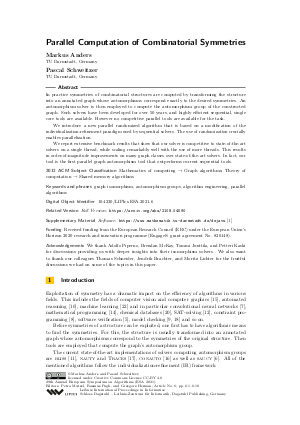@InProceedings{anders_et_al:LIPIcs.ESA.2021.6,
author = {Anders, Markus and Schweitzer, Pascal},
title = {{Parallel Computation of Combinatorial Symmetries}},
booktitle = {29th Annual European Symposium on Algorithms (ESA 2021)},
pages = {6:1--6:18},
series = {Leibniz International Proceedings in Informatics (LIPIcs)},
ISBN = {978-3-95977-204-4},
ISSN = {1868-8969},
year = {2021},
volume = {204},
editor = {Mutzel, Petra and Pagh, Rasmus and Herman, Grzegorz},
publisher = {Schloss Dagstuhl -- Leibniz-Zentrum f{\"u}r Informatik},
address = {Dagstuhl, Germany},
URL = {https://drops.dagstuhl.de/entities/document/10.4230/LIPIcs.ESA.2021.6},
URN = {urn:nbn:de:0030-drops-145875},
doi = {10.4230/LIPIcs.ESA.2021.6},
annote = {Keywords: graph isomorphism, automorphism groups, algorithm engineering, parallel algorithms}
}

 Creative Commons Attribution 4.0 International license
Creative Commons Attribution 4.0 International license

